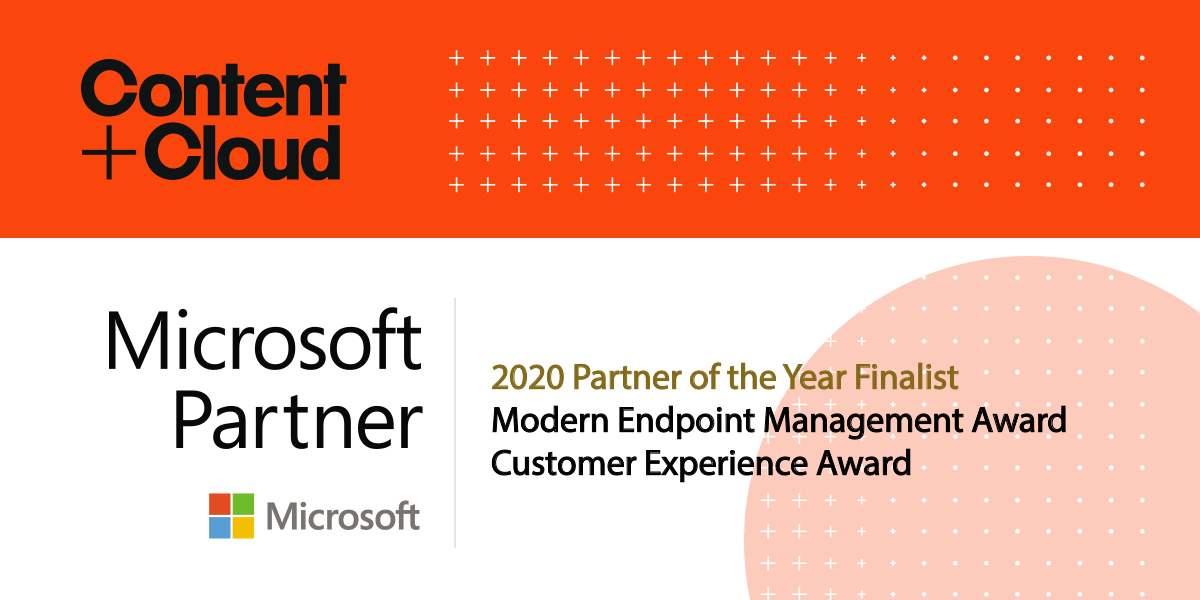
Frequently asked questions for governance in SharePoint Online
Working for a Microsoft Gold Partner in a client-facing role, not a day goes by where my colleagues and I don’t have at least one conversation about SharePoint governance. Often, these conversations are initiated by organisations about to migrate to the cloud or already on their journey.
And the last few months have compelled a record number of companies to move to cloud-based productivity tools, so they can run remote workforces and continue to operate.
Many organisations took a ‘lift and shift’ approach when they migrated to SharePoint Online. Deployments were typically at speed, without proper planning and governance. And unfortunately, the consequences are now being keenly felt, especially as business and IT leaders begin to encounter ungoverned territory!
As we see some questions repeated time and time again, we thought it would be useful to share the answers here.
Why does SharePoint governance matter?
SharePoint Online is fundamental to M365. It’s widely known for its document management capabilities and for offering simplicity when creating modern sites for collaboration and communication.
SharePoint is core to the Microsoft 365 product suite because it underpins other services like Teams, Yammer, and Stream. Their reliance on SharePoint is one reason why it’s vital to implement a governance plan. The consequences of limited or poor governance include:
- Unstructured content impacts on efficiencies and user experiences.
- A lack of control can lead to data leakage and compliance and security risks.
- An ungoverned environment can rapidly descend into a wild west of content which is increasingly tricky to manage.
- Without rules, it’s impossible to automate processes around, for example, data retention periods and deletion.
What is SharePoint governance?
Microsoft’s definition of governance is:
‘A set of policies and processes, roles and responsibilities that are put in place to support our SharePoint users to manage and protect an organisation’s data’.
Ultimately, the aim is to manage and protect your data throughout its lifecycle. With the help of some governance, you can achieve this in Microsoft 365.
No two organisations will share the same governance framework. The necessary level of governance depends on the size of your organisation along with the types of solutions and sites you use SharePoint for.
A SharePoint governance framework is a plan that documents:
- Rules, configuration settings and activities.
- Individual roles and the responsibilities of each role.
- Any associated processes that are best practices for managing the lifecycle of content in your organisation.
The purpose of the governance framework is two-fold:
- To guide your users, e.g., by implementing guardrails for the correct behaviours.
- To keep pace with Microsoft’s evergreen model for M365, which means maintaining and regularly updating your framework.
A broader governance framework for Microsoft 365 brings noticeable benefits to your organisation. These could include:
- Assistance with streamlining your M365 deployment, making it much easier to map use cases to specific technology solutions.
- Security and compliance. Ensuring your data is secure and that your organisation meets relevant compliance obligations.
- Consistent processes. Clearly defined processes can become repeatable with little or no intervention.
And of course, these benefits can also help to boost your return on investment, which can only be a good thing!
Isn’t SharePoint governance just permissions and training?
Governance includes permissions and training. And for small organisations using SharePoint in limited ways, then getting to grips with these two things might be enough.
But for larger organisations using SharePoint extensively, the scope of governance is much broader.
All technology and product experts need experience and training in the product they’re responsible for. When it comes to SharePoint, several roles are necessary for a full SharePoint rollout, including SharePoint Administrators, Site Owners, Term Store Administrators and Content Editors.
And as well as these roles, there’s a requirement for support and, in some cases, custom development. Each job calls for a different set of knowledge and skills.
Should I just lift and shift all my content into SharePoint Online?
As mentioned at the top, some organisations do perform a ‘lift and shift’ of their content into SharePoint. In some circumstances, this may be okay. But it’s also a lost opportunity.
Migrating your content into SharePoint Online is the perfect time to cleanse your data, ensure all content has assigned owners, and review what’s used and how often.
This exercise will help you to determine what data to migrate, and what should be deleted or archived. After all, what’s the point of migrating content that’s never used?
Besides what you want to move, understand why you’re moving your content into SharePoint. If you have headaches around finding information because of poor structure, inadequate search functionality, or limited collaboration abilities, a ‘lift and shift’ approach will transfer these problems into SharePoint Online.
By leveraging the features and capabilities of SharePoint that are included in your licensing right out of the box, you can fix these things. And not only that; you can make things better.
So, before migrating to SharePoint Online, look at creating a solid information architecture. We do this on behalf of many organisations, so do get in touch if you could use a hand.
Of course, this can mean substantial changes to ways of working and what your end-users are accustomed to. While there will always be some resistance to change in various quarters, you can gently overcome it with business change and user adoption support.
We can’t overstress the importance of communicating with your end-users at the earliest stage and helping them understand the value behind what you’re doing.
Do I need a new team, or extra people, to use and govern SharePoint?
No, it’s not necessary for you to muster a new team for SharePoint! You might need to add one or two new roles to your team, but this will depend on your organisation’s size and structure, and the extent of your use of SharePoint.
Your existing team already has a wealth of knowledge. They can see under the hood of your company and understand your goals, practices, and processes. So, with a little adjustment to their roles and some new responsibilities, they’re the people best placed to help.
The recipe for a winning SharePoint deployment is:
- Sufficient training; both for those managing SharePoint, and those using it.
- Solid information architecture.
- An appropriate level of governance
- And the special sauce; healthy user adoption.
Could you use some extra, expert support to get cooking? Then why not ask for a free ‘Art of the Possible session? See how we can help you here.
How do I go about creating a SharePoint governance plan?
A governance plan sounds heavy, but all it means is documenting how SharePoint is used and managed in your organisation.
You’ll want to publish your guide in a way that’s easy for people to access and consume. This could be a document that’s stored on your intranet or document management system or even as SharePoint pages.
Your SharePoint governance plan should include the following sections:
Your vision and goals for SharePoint
Regardless of whether you’re using SharePoint as a document management system, a company-wide intranet, or as a complete collaboration tool, communicate your ambitions from the start.
Such comms are usually done from the top down, sending the message that senior stakeholders are on board. Clear lines in the sand will also prevent SharePoint from becoming a dumping ground for everything and avoid (or at least reduce), content sprawl.
SharePoint roles and responsibilities
Everyone must know how they’re involved and what their role in SharePoint is.
Top tip: it’s helpful to add these duties to individuals’ job descriptions. This will ensure there’s no confusion of responsibilities and that people are recognised for their contributions.
SharePoint information architecture
For a SharePoint environment that is well-structured, scalable, and flexible, a solid information architecture plan is crucial. Here are the elements it should contain:
- SharePoint site structure – determine the types of sites you’ll be using – communications or team sites, along with your use of Microsoft 365 group sites and hub sites. If there’s a provisioning tool for self-service site creation, show how governance plays into this.
- Security and permissions – utilising M365 Groups enables secure access to different collections of shared resources; this is the recommended security method for SharePoint Online. Consider any custom permission levels that might be necessary, on top of the standard SharePoint permission levels.
- Site administrators – ensure you have adequate administrators for each SharePoint site; at least two. The site admins and owners should determine whether to enable external sharing or not.
- Navigation – it’s vital that end users can move comfortably between sites and find information via organised navigation menus for top site navigation, quick launch navigation and hub site navigation.
- Branding – brings your corporate identity to your SharePoint sites. Logos and themes with company colour schemes enable fast recognition of department or project sites. You could include branded templates in SharePoint too.
- Taxonomy – a classification system allows you to define and add words and phrases that are relevant to your organisation to the Term Store. These terms can then be used across your sites to classify your content with managed metadata.
Wrapping up
SharePoint governance is essential; it’s about getting the balance right and avoiding overkill. If you implement policies that disable features and lock everything down, you could inadvertently stymie your users’ adoption of SharePoint.
If your governance gets in people’s way or slows them down, they might choose to ignore or circumvent the rules. Or they could turn to third-party tools, which is plainly far from ideal and will give you another set of problems.
And remember, if your users misbehave, their intentions are probably good; part of your role is to prevent any disconnect.
So, aim for a level of governance that protects your data while equipping your users with what they need to do their best jobs. Happy users will set you on the right path to successful SharePoint adoption, bringing value and efficiencies to your organisation and a great return on investment.
For more IT insights and wisdom, tap into Digital Revolution Live on-demand. Watch our Clare Jordaan and Oli Stickley in action as they discuss ‘Getting a handle on governance for Microsoft SharePoint and Teams’. And you’ll be able to pick and choose from a host of other topics tackling the challenges we know you face.
And we’d love to help you even more; check out our free ‘Art of the Possible’ sessions by clicking below.



